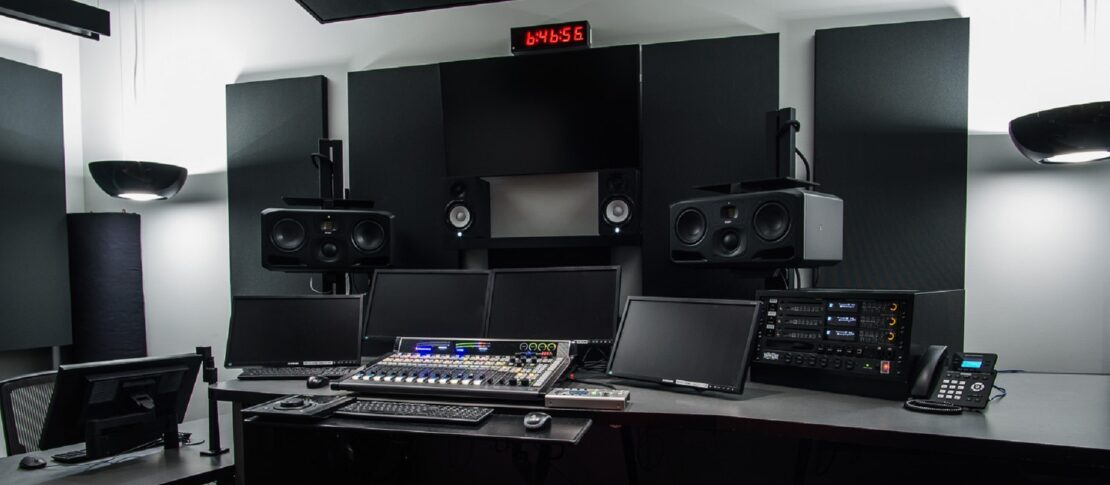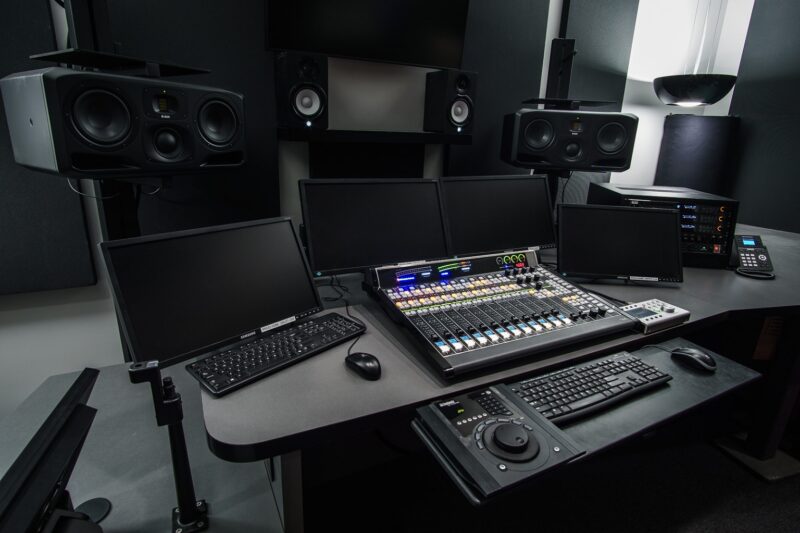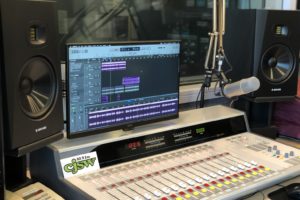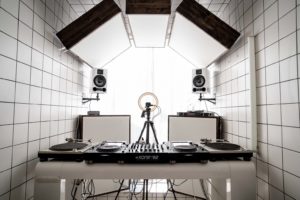
KEXP
Cheryl Waters, Jamie Alls and Kevin Suggs from the Seattle broadcaster speak candidly about recording The Polyphonic Spree in a closet, getting recognized in Mexico City and the power of saying “yes”.
Pete Armitage caught a precious few minutes with the team as they took a breather from their busy schedule. Upon initial examination it’s frankly quite difficult to see who or what KEXP is. Indeed, it isn’t too far-fetched to posit that even the station itself doesn’t quite know how they are perceived. The broadcasting giant seems to be one of those peculiar rarities in the 21st century that has grown (exponentially) almost by accident.
Jamie Alls, Director of Engineering since 2011 seems as puzzled as us about how the station became ubiquitous.
“We have one guy dedicated to marketing. And no budget. We’re tragically bad at it.”
Is it simply due to the consistent delivery of the highest quality content across audio and video platforms? Probably. Jamie transmits a casual cool when discussing the journey so far, alluding to an almost serendipitous series of events that somehow landed KEXP where it is now. The outfit is a role model not only in the astounding quality of its content but in its community values too, which are listed proudly on their website:
- Music has the power to transform lives and connect people across all boundaries.
- Principles of inclusivity, diversity, and equity– held tightly and put into action through a chosen shared mission– can help create the world we want to live in.
- Listener power inspires and sustains everything we do and everything we are, and we thrive by practicing gratitude for those who support us.
- To honor the trust of all of our communities, it is our responsibility to continuously experiment, evolve, and push ourselves and others forward, and to approach our work with vulnerability and relentless curiosity.
- Creating an enriching experience with music requires us to celebrate music that spans eras, styles, and traditions, and to support artists who challenge musical conventions.
- As a global community of music lovers rooted in Seattle on the traditional land of the Duwamish and Coast Salish People, we must strive to remain accountable to every community we touch- at home and around the world.
Station beginnings
The KEXP story began back in 1972 as a 10-watt station broadcasting across the humble University of Washington campus. In the formative years of the station, its calling letters were KCMU, referring to the campus communication building “CMU”.
After nine years of operation, the students behind the operation were forced to seek alternative funding methods, turning to the local community. Around this time in the early 1980s the station was presenting itself as a modern-rock outfit, forming strong bonds with its listeners who pledged donations ultimately ensuring its survival. Later in the ‘80s, the music policy of the station diversified, with programming expanding to include hip hop, reggae, jazz and more. This is when the “play what you want” approach really came to be a part of the station’s DNA, a formula that catered to many students’ taste as well as being an opportunity for them to learn about radio and music they otherwise might not be exposed to.
In 2000, KCMU made history, becoming the first radio station to transmit mp3 audio online 24/7. The station also moved its premises across campus from the old communications building to Kane Hall. By then, they averaged around 56,000 listeners per week, supported by 2,800 annual donors. Indeed, this devout listener-ship has existed for decades. Jamie explains that their custody and protection of the station has been present for as long as he remembers.
“Over the years technology has gradually increased our footprint, and some milestones along the way have changed who we are. Whenever anything changed majorly there was tons of concern in the community about what would happen to the station. It’s always been so valued and cherished by the listeners.”
He recalls one major instance of this phenomenon when the station changed its calling letters and moved off campus:
“Back in the early 2000s, the Microsoft partner Paul Allen was funding things, so there was a ton of investment coming in and a big facility was built for us off campus. It was great news for the station but suddenly there were all these articles asking if Paul Allen would be choosing the music! It was crazy – the community has always been so protective of things.”
KEXP has since expanded into a globally recognized institution. Although still operating as a traditional FM radio station, the organization is arguably best known internationally for its Youtube channel. Jamie points out however that these two listener-ships often don’t seem to know about each other.
“The people aware of us locally don’t necessarily know we have this international presence at all. On the flip-side people on YouTube don’t know we are a local radio station. We have done these things like going to London for International Clash Day in London and people recognized Cheryl (our midday show host) on the tube. The same thing happened in Mexico City actually. Cheryl was getting recognized by the public there too – it’s mind-blowing! It’s funny ‘cos it’s not that huge an operation really – it just seems to grow out of the local thing.”
The KEXP mission
Jamie is keen to illuminate the three distinct communities that are served by the Seattle broadcaster. Firstly, the local Seattle folks of whom a significant proportion form the ‘diehard’ KEXP fans. These are the custodians that arguably form the fabric of the listener-ship, protecting the station’s interests, and questioning any apparent changes in tack from those at the helm over the last 48 years.
Secondly, the wider international listening community (somewhat represented by the 2.6+ million subscribers on their Youtube channel). Jamie provides an unexpected and characteristically understated answer to the question as to how the now gargantuan video branch of KEXP’s operations began. “Basically, these videographers just came in and asked if they could record the bands while they performed. We just gave them the go-ahead and didn’t say no. And it’s just grown from there organically! It’s a real lesson I guess – just say yes and good things will happen.”
Thirdly, and crucially, there is the large community of artists that come through KEXP’S doors. They truly are another distinct group that has their own particular needs. Jamie elaborates, “we really care about the artist community, and that trust is built up over a long time. We choose artists based on whether we like their music or not, and we really try to exist outside of the whole creepy music biz stuff – we just try to support them. Our programming team are all music fans and share music simply because they want to.”
In fact, the dedication to individual scenes and artists by DJs like Cheryl Waters (who has been on air at KEXP since 1994) is a testament to the station’s success – she is constantly on the lookout for fresh talent both locally and internationally.
“I love that KEXP has an international reach, and I’m always discovering new artists from all over the world. We’ve done remote broadcasts featuring band performances from Iceland, Poland, France, the UK, Canada, and Mexico and had plans to travel to Denmark and Argentina in 2020 before the pandemic shifted our sessions to the Live at Home format. However, I must also mention the staggering amount of local talent here in the Pacific Northwest. I’m always striving to keep a thumb on the local scene, and to bring those artists in for in-studio performances. KEXP thrives due to the strength of our local music scene, and even our listeners in other cities, and other countries, are ecstatic to hear what’s new out of Seattle.”

Technical setup
Jamie recalls humble beginnings at KEXP before the current more sophisticated setup was in place.
“As we’ve moved from place to place, our technical ability leapt with our equipment upgrades. We didn’t have a video infrastructure in our last place, and that was 6000 square meters. We literally started with a video control room in a closet, with another guy trying to do his work in there at the same time! The place was super cramped. We even had huge bands like Polyphonic Spree performing there with over 20 members. The bass player had to record out in the hallway with the DI. It was really nuts!”
Kevin Suggs, the primary audio engineer for live sessions is keen to spill the beans on some of his regularly used gear, sharing an insight into the current signal path from performer to listener:
“We use standard workhorse mics. Shure SM57s or Sennheiser 609s on guitars and Shure SM58s on vocals. We have a few more esoteric mic choices that we pull out from time to time but mostly it’s the tried and tested. My philosophy is to keep it simple because I don’t want any surprises live on air. Our mic preamp selection is stellar. API, Millennia, Chandler, Avalon, Pacifica, and Universal Audio. From there it hits the Avid 192 I/O and into Pro Tools. We mix from an Avid S6 Console. Most EQ and compression is done in the box with mostly the stock Avid plugins.”
“We have a few non-Avid plugins but like to keep the system lean and mean to minimize crashes. It is live radio after all. We send the mix to the DJ control room where a board operator will throw up the appropriate fader to put the live room on the air. The FM feed has an 8 sec delay and there is a dump button just in case someone let’s a bad word slip! We have a full backline as well in case someone wants to borrow an amp. A grand piano as well. Worth mentioning our very sweet mid-70’s Ludwig drum kit too. That gets used on most sessions – drummers love it!”
COVID-19
Despite the scale of the operations at KEXP and their committed fanbase, COVID-19 brought about many changes, and the team were forced to completely rework their usual schedule in order to stay on air.
From the very beginning, station policy remained characteristically community-orientated; grounded in a dedication to their values and an unflinchingly deep empathy for listeners and artists alike. On 12th March 2020, before things got serious, the team published a “Guide for Artists and Fans to Support Music During the COVID-19 Outbreak”, noble by any measure and setting a precedent in the industry.
Jamie reflects on those early days of the pandemic:
“I was actually just looking at a letter we got from the government at the time saying we are first responders – we were allowed to be out in order to keep broadcasting. That was quite surreal. I remember thinking ‘how are we gonna keep the station running?’” Due to the nationwide restrictions and the fact that some staff and presenters were in a high risk category, the crew had no choice but to make operations remote.
“We got beefier internet connections for folks to send live audio without issue. Then we created these little broadcast packages to enable presenters to broadcast from home.”
Cheryl recalls that her immediate thought was how the team could continue to provide live music to the community – a vital part of the listeners’ lives and one of the first things to vanish during the pandemic.
“The ‘Live on KEXP at Home’ sessions that we’ve transitioned to have been a constantly evolving collaboration between KEXP, the artists, and those who work and support artists such as their record labels and management companies. We’re super lucky to live in a time where so many have easy access to technology. The first few sessions we hosted were really bare bones performances, with artists playing a few songs acoustically in front of a webcam, and then chatting with a KEXP DJ. I love those sessions – it really represents how important live music and community was, even in those first few scary months. They were nothing fancy but showcased the immense talent behind artists like Waxahatchee, Moses Sumney and Christine & the Queens.”
Furthermore, DJs being able to broadcast from home actually increased the diversity of musical output, as Jamie notes fondly. “Suddenly each of our DJs had access to their own music collection to play on air – they had access to all this cool stuff that we didn’t have at the station. In particular, I’ve got to remember our afternoon and drivetime DJ Kevin Cole. He has a bigger collection than KEXP, it’s downstairs in his house and is just nuts. It’s all crazy remixes and vinyl only, or things that had a limited run in ‘89. That kind of stuff.”
The disturbances of the pandemic also encouraged change in other areas of the station’s operation, a prime example being a further dedication to diversity and inclusivity.
“We made some big changes in 2020, pledging to bring in more BIPOC voices. We shortened some shows to make room for others and spent even more time looking for special voices to platform within the community. The response to this has been overwhelmingly positive and the programming is even better as a result!”
ADAM Audio S3H
Jamie was also kind enough to share a few words about how the broadcaster’s ADAM Audio S3H have contributed to the KEXP mission.
“They are amazing, everyone is really impressed with them. We were looking for a specific application for mastering and achieved that. My personal impression is that they are super detailed. I’m hearing things in mixes that I’ve just not heard before. We’re currently considering getting another pair for our live room too.”
Listen to KEXP here and subscribe to their Youtube channel. We spoke to KEXP as part of the ADAM Audio Community Radio series, a new project exploring the worlds of broadcasters and their journey with ADAM Audio products.

